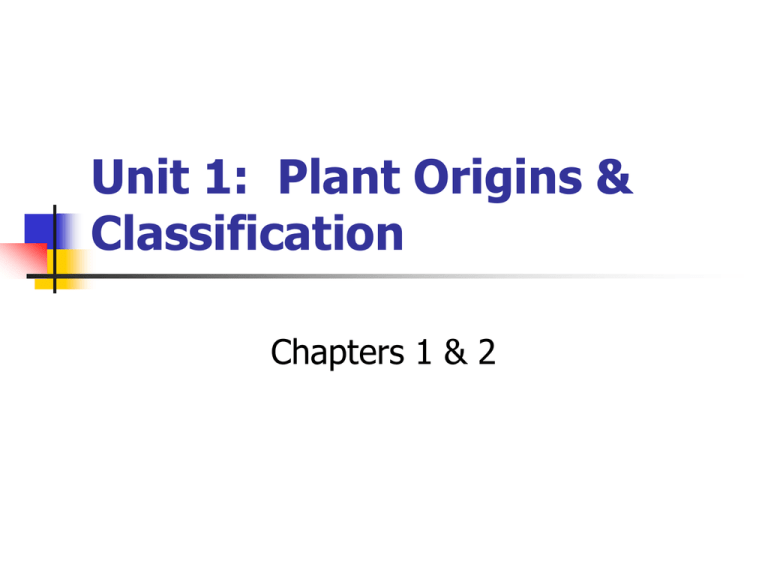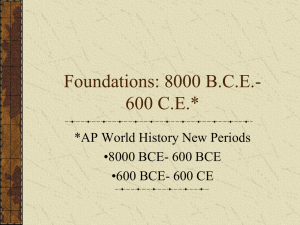Unit 1: Plant Origins & Classification
advertisement

Unit 1: Plant Origins & Classification Chapters 1 & 2 Unit 1: Plant Origins & Classification Unit 1 Objectives Understand the importance of taxonomic systems and their uses Basic knowledge of divisions of plants Appreciation for how today’s crops were developed, and the importance of continued research Unit 1: Plant Origins & Classification Introduction Traditionally: two basic kingdoms Animalia Plantae Classified due to several factors: Stationary Manufacture their own food Continuous growth highly affected by the environment However, many do not fit well into either category, so other kingdoms have been established Unit 1: Plant Origins & Classification Monera Bacteria and blue-green algae Protista Mycota Fungi Plantae All other algae and protozoans Mosses, ferns, seed plants Animalia Unit 1: Plant Origins & Classification Evolution of Plants Scientists date life back 3.5b yrs. Bacteria Blue-green algae Algae is responsible for supplying oxygen to the atmosphere to support other life forms Land plants begin to appear ~400m yrs. ago Unit 1: Plant Origins & Classification Geographical Distribution of Plants Plants are not found only in the most extreme climatic conditions What are they? Distribution can vary depending on the plant Some extremely adaptable Some very specific What can they be adaptable/specific to? Why are they this way? Unit 1: Plant Origins & Classification Climate is the major determining factor Most varied plant population occurs at/near the equator Moisture and temperature are almost never limiting How do plants adapt? Dry climates Develop Xeromorphic Characteristics (dry form) Small, thick leaves Spines Unit 1: Plant Origins & Classification Colder climates Growth close to the ground Protected growing points at/just beneath the ground Climatic Zone Dense hairiness Water-storage organs Plants in a similar area form a characteristic vegetation type Biome Large area encompassing characteristic vegetation and animal life Unit 1: Plant Origins & Classification Major biomes include: Tropical forest Desert Tundra Roles of Plants Basis of the food chain and energy flow Ability to convert inorganic compounds into organic compounds in living tissues Extra energy not used for critical plant life processes is converted to new tissue (biomass) Unit 1: Plant Origins & Classification Edible Plants Concentrated portions of a plant Most important food plants are of the grass family Seeds, fruits, tubers, foliage Wheat, rice, corn, sorghum, barley Plant foods consist of 88% of world’s calories, and 80% of proteins Inverse relationship between high plant based diet and development of a country Unit 1: Plant Origins & Classification Plants also a major source of world’s beverages Can you name them, and what they are used in? Industrial Uses Plants play a major role in virtually all products that we have today Ex. How many products can we name that originate from trees? Unit 1: Plant Origins & Classification Medicinal Uses Compounds from plants can be converted to very useful medicines In nature, and at the wrong concentration, they may be poisonous Oils Food reserves stored by the plant in seeds or fruits Name some of the most common oil plants! Unit 1: Plant Origins & Classification Taxonomy Ways to classify plants Phylogenetic – how they look Environmental – where they grow Agricultural – what use they are grown for Natural/Morphological – how their structure compares Unit 1: Plant Origins & Classification Terminology Taxonomy Nomenclature System used to organize plants into a classification System used to assign names to plants Artificial Classification Systems Climatic or agricultural classification systems Depends on: The climate the plant grows in Its uses How the environment impacts it Unit 1: Plant Origins & Classification Botanical Systems The first method used for plant classification Classification by morphology (size, form, texture) Not used much today, but its influence is still very apparent Taxonomic Classifications Divisions within a taxonomic system are called taxa (ex. kingdom) Unit 1: Plant Origins & Classification Most agricultural plants are considered to be members of subkingdom Embryota (land plants) Divisions Thallophyta – algae and fungi, no tissue differentiation Bryophyta – green plants w/out roots (mosses) Pterodophyta – green plants w/ vascular tissue, roots, leaves, stems, no flowers Spermophyta – plants w/ true flowers and seeds Unit 1: Plant Origins & Classification Spermatophyta Produce true seeds Contain an embryo that will germinate under specific conditions True leaves, stems, roots, and vascular tissue Make up the greater majority of vegetation Two classes: Gymnospermae Naked-seeded Woody, perennial, mostly evergreen Unit 1: Plant Origins & Classification Reproductive structures are cones Leaves may be fernlike, scale like, strap-shaped, needle-shaped Angiospermae Flowers and seeds that are always protected by fruit Further divided by the number of seed leaves found in the seed (cotyledons) Monocotyledoneae – one cotyledon in the seed, parallel veined leaves, flower parts in 3’s or 6’s, no pith or bark on the stem but can be treelike Ex. Grasses, cattails, lilies, bananas, bamboo Unit 1: Plant Origins & Classification Lower Subdivisions Dicotyledoneae – two cotyledons in the seed, net-veined leaves, flower parts in 4’s or 5’s or those multiples, various flower types/forms Ex. Willows, roses, magnolia, honeysuckle Order, Family, Genus, Species, Form, Variety/Cultivar/Clone Plant ID and Nomenclature Most all names are derived from Latin or Greek Can give hints to characteristics of the plant Unit 1: Plant Origins & Classification Binomial Nomenclature Plant has 2 parts to its name (Genus & Species) Naming is based on flowers and/or reproductive structure Very effective because these parts are not influenced by the environment Knowledge of flowers and its parts essential to good plant ID Other Subgroups Can have a third cultivar name or botanical variety Botanical variety is a plant that is similar, but different from the wild version Unit 1: Plant Origins & Classification Cultivar refers to cultivated variety The future of taxonomy Will include: Chemical analysis Specific protein analysis DNA analysis – genetic finger print More use of highly powered microscopes to very closely examine plant processes, hormones, etc. Unit 1: Plant Origins & Classification Origin & Development of Cultivated Plants Two main regions: Asia in the Old World Central Mexico to Chile in the New World Neither area new what the other had until transatlantic exploration began Unit 1: Plant Origins & Classification Unit 1: Plant Origins & Classification New Crops & New Uses Has been a major focus in America since Colonial times Using surpluses and decreasing demand on foreign products both in agricultural and industrial sectors Early American Adaptations Americans have always been responsive to market needs Corn, potatoes, squash, and tobacco has been grown in the U.S. for many centuries Unit 1: Plant Origins & Classification Some where exported back to Europe Corn and Potatoes where adopted quickly because of their relative ease of production and high use Tomatoes were suspected to be poisonous and took many centuries to adopt Americans had to turn to other crops in order to control surpluses in order to compete w/ Europe Tobacco, rice, cotton, timber Unit 1: Plant Origins & Classification Beginnings of Agricultural Research USDA founded in 1862 First focus was to collect seeds for distribution to farmers and for research Hatch Act 1887 Set up experiment stations at land-grant colleges Initial research focused on increasing productivity w/ better practices and varieties Created surplus problems Research had to turn to additional uses for commodities Unit 1: Plant Origins & Classification WWI had a great impact on the development of new plants and uses in the U.S. due to supply cutoff Specifically medicinal plants Overproduction of cotton threatened the market in the southern U.S. Through research and development, Carver convinced many growers to plant peanuts and sweat potatoes Founded peanut oil Peanut acreage grew 4x from 1910 to 1940 Carver also founded new uses for cotton and soybeans Unit 1: Plant Origins & Classification Agricultural Adjustment Act 1938 Response to severe surpluses and lack of export market Established 4 national research stations geographically based on crops grown in that area WW II Stimulated research due to needs for the war Many new products/uses developed Synthetic rubber, dehydrated foods, etc. Mass production of penicillin Unit 1: Plant Origins & Classification Postwar Research Attention again focused on dealing w/ surpluses due to soaring production as a result of advancements in chemicals/machinery Development of many other products Frozen orange juice – stimulated production of O.J. concentrate from 226,000 g in 1945 to 84,000,000 g in 1960 Other frozen foods Instant potato flakes Wrinkle-resistant cotton Unit 1: Plant Origins & Classification New Sources of Demand Response to rising surpluses, increased productivity, and dependence on foreign materials High oil prices of 1970’s stimulated research in ethanol and soy ink Much focus has been centered on biodegradability and conservation of natural resources Unit 1: Plant Origins & Classification Most research has focused on increased uses for current products Less research on the introduction of new plants due to difficulty in getting them to grow in the climate and resistance of farmers to grow new crops Guayule – for rubber production Kenaf – substitutes for wood pulp in paper production Crambe – industrial oil Unit 1: Plant Origins & Classification The Future We have the research base and facilities to greatly expand our research if/when needed Demand for research will continue to be great to meet needs for new crops and decrease demand on foreign imports New uses and products would increase the need for manufacturing and process plants which would stimulate the economy Unit 1: Plant Origins & Classification Protection of Germ Plasm <.1% of plant species are used in agriculture Scientists are concerned about preserving this resource Genes can be used in the future to create new plants, new product uses, or have crops that will adapt to adverse environments More genes will be added to the pool for future uses Unit 1: Plant Origins & Classification Unit 1 Assignment:









